Essential Peruvian Food: 10 Must-Eat Dishes to Seek Out
Don't miss these unique bites on your next visit to Peru.
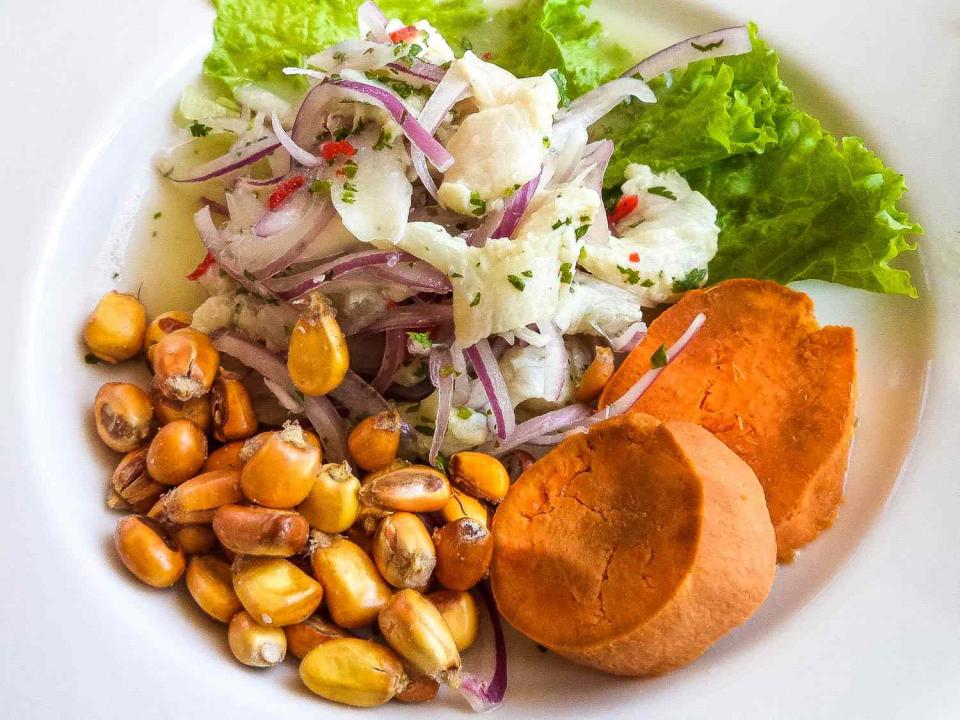
Serious Eats / Kevin Cox
My first encounter with comida Peruana was over 20 years ago, thanks to my wife's Peruvian family. Their cooking was a study in juxtaposition: hot and cold, acidic and starchy, robust and delicate. That's because Peruvian food is all about spices and big flavors, some clean and crisp, others deep and heavy. Every sip of a pisco sour tamed the citrus and chile assault of a ceviche, the fish so fresh it almost crunched between my teeth.
When most of us think of Peru, we think of the ancient ruins and high mountain vistas. Those thoughts may be accompanied by a distant pan flute whistling over the Andes, and if we've been primed on the food, the conversation usually starts with the country's mind boggling variety of potatoes.
But culinarily speaking, Peru is the Hope Diamond of Latin America, home to dishes and flavors you won't find anywhere else. While this is hardly a secret—there are more Peruvian restaurants outside Peru than ever before—it's one we don't give enough credit. Few places on earth offer such a variety of indigenous ingredients, let alone a jumble of flavors and techniques from Europe, Africa, and East Asia. Rather than remain culturally segregated, these foreign additions have blended seamlessly with ancient Peruvian cuisine into something utterly unique.
A Peruvian Primer
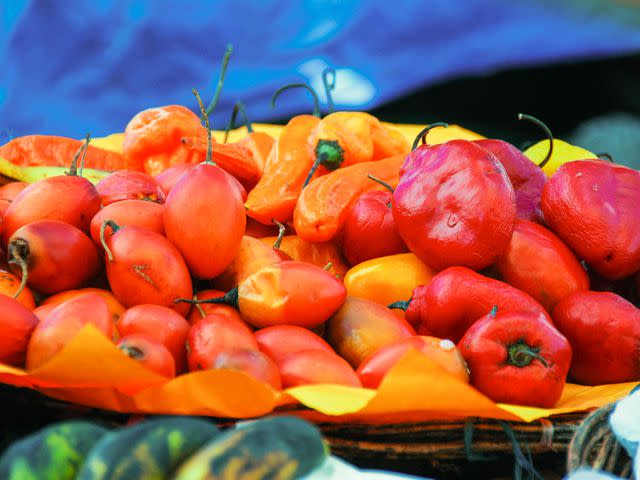
Serious Eats / Kevin Cox
Peruvian cuisine has only recently exploded onto the international culinary stage, but Peruvians have always been crazy about their nation's culinary heritage, and they steadfastly cling to the traditional, multi-culti flavors of home —pit-roasted feasts and all, even in the face of modern gastronomic innovation. A range of climates, from high altitude to low, offer an impressive diversity of produce. Yes, that means potatoes—over 3800 kinds—but also a variety of corn and other grains, to say nothing of the country's native aji chiles that are often puréed into sauces.
So much of what is now traditional Peruvian cooking was inspired by cultures oceans away. These foreign influences date back to the Spanish conquest of Incan king Atahualpa in the 1500s. Colonists brought European stews, sauces, and baked casseroles. Later, in the 19th century, immigrant workers from Guangdong Province brought their woks and stir fries, and Peruvians today love to eat chifa, a fusion of local ingredients cooked with Chinese recipes and technique. It's Chinese food with Peruvian influences—or maybe the other way around.
Like food everywhere today, there is a new style of Peruvian cuisine emerging—so-called nueva comida—forged by Lima's leading chefs like Gaston Acurio and Pedro Miguel Schiaffino. "It's very ingredient-driven," explains New York chef Eric Ramirez of Llama Inn and formerly of Raymi Peruvian Kitchen and Pisco Bar. "With young chefs digging deep to find more exotic ingredients, the possibilities are endless." So the evolution of the nation's food continues, into territories of modernist cooking that's simultaneously old and new.
But for now, here's a quick tour of just some of the classic edible jewels Peru has to offer. Consider it the checklist for your next trip.
Ceviche
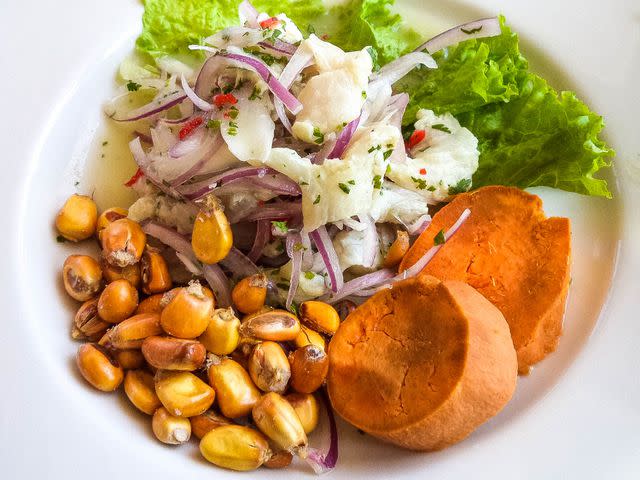
Serious Eats / Kevin Cox
Ceviche is Peru's national dish, and an immediate infatuation for nearly all who try it. Though other countries may claim their own variations with shrimp, octopus, scallops, tomatoes, and even tostada chips, Peru started this cold-"cooked" fish craze with only five simple ingredients: sea bass (corvina) marinated for just minutes in lime juice, onion, salt and, of course, hot chiles (aji). The tenderness of super-fresh fish is heightened by crisp onion, and sides of starchy boiled corn (choclo) and creamy sweet potato (camote) to balance out the texture of the dish. Dry-roasted corn kernels (cancha) sprinkled around add a pleasing crunch.
The leftover marinade—known as leche de tigre (tiger's milk)—is a briny, fiery elixir often tossed back from a shot glass or spiked with Pisco, either at the table or the next morning as hair of the dog. (In the latter case it's then referred to as leche de pantera, or panther's milk). Tiradito is a local variation of classic ceviche with a Japanese sushi-style twist of slicing the fish into thin strips, then adding puréed aji amarillo, soy sauce, and mirin to the marinade.
Lomo Saltado (Stir-Fried Beef)
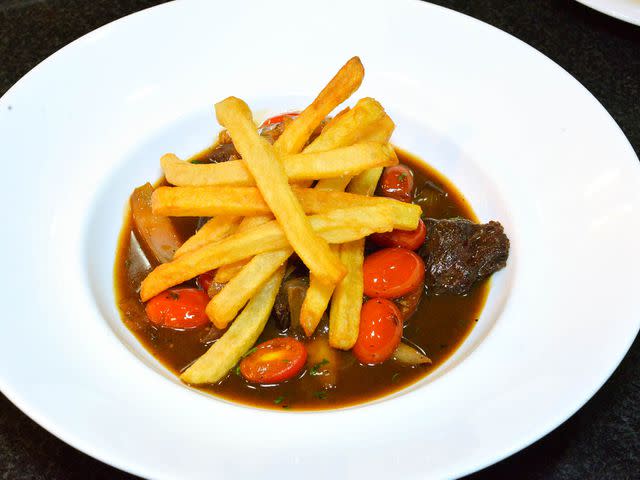
Serious Eats / Kevin Cox
Almost as popular as ceviche, this chifa dish represents a fusion of Chinese stir-frying and classic Peruvian ingredients. Juicy strips of soy-marinated beef (or alpaca), onions, tomatoes, aji chiles, and other spices are stir-fried until the beef is just cooked and the tomatoes and onions start to form a robust, meaty gravy. It's then served with two starches, a happy mix of East and West: a mound of rice and french fries (often tossed with the meat). The crowd-pleasing dish is found nearly everywhere across Peru, and is equally popular in Peruvian restaurants abroad.
Aji de Gallina (Creamy Chicken)
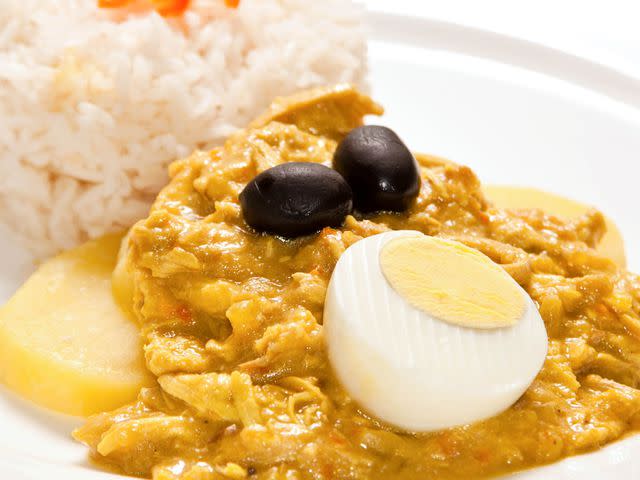
Daniel Noboa / Shutterstock
Shredded chicken bathes in a thick sauce made with cream, ground walnuts, cheese, and aji amarillo. The sauce is mild but piquant, the aji's fruity, moderately hot bite softened by the nutty, creamy sauce to a comfortable warmth. The dish reflects Peru's love of sauces thickened with chiles, cheese, cream, or even bread, and often cooked with meats and vegetables. Here the sauce is mixed with the poultry and served over rice with boiled potatoes and black olives, making for a rich, bright yellow chowder that glistens on the plates of restaurants and households throughout Peru.
Papas a la Huancaina (Potatoes in Spicy Cheese Sauce)
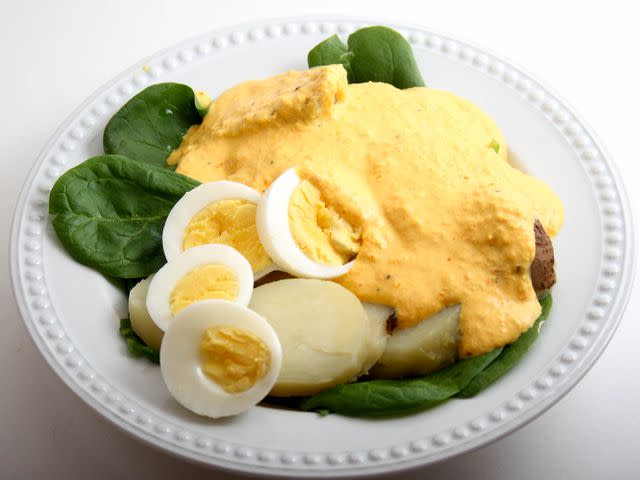
Alan Sheffield / Flickr
In another instance of "meat or starch covered in creamy sauce," sliced yellow potatoes are drenched in a purée of queso fresco, aji amarillo, garlic, evaporated milk, lime juice and—you guessed it—saltine crackers. It's not a looker: a yellow sauce over yellow potatoes topped with yellow-yolked hard boiled eggs. But don't be deceived; this homely sauce packs a complex, slow-building burn, at once brightened by the queso fresco, lime, and salty cracker, and tamed by the earthy potato and cooling egg.
Usually served as a side dish to a meal, it's also a common appetizer, with tiny round purple potatoes boiled whole, enveloped by sauce and garnished with olives, eggs, and, yes, more crackers. Originating in the mountainous city of Huancayo, it's now an almost everyday staple throughout Peru.
Cuy (Guinea Pig)
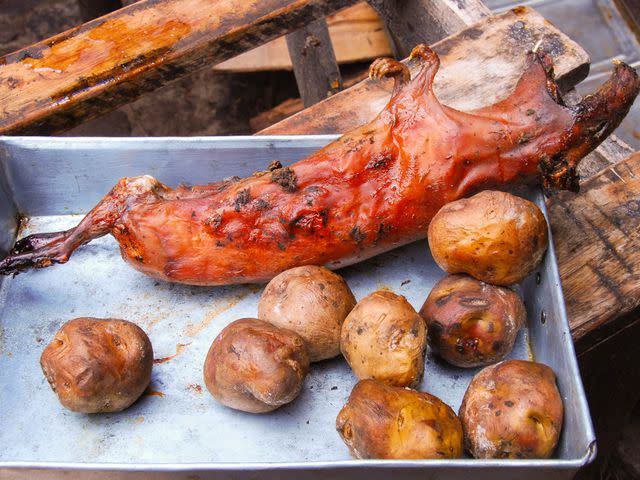
Serious Eats / Kevin Cox
One of the Andean region's most popular sources of meat (the other being alpaca), this guinea-pig-as-food strikes fear in the hearts of Westerners who think of it more as a pet than a meal. But consider tender, smoky dark meat (almost like poultry!) beneath a glistening golden veneer of shatteringly crisp skin, and you can begin to grasp the appeal. Or think of it as a single-serving suckling pig.
The traditional recipe calls for stuffing the whole animal with local herbs, then roasting it over an open wood fire and serving it with potatoes. When served this way it tastes best with a dip of aji sauce and eaten by hand like fried chicken. But more refined restaurant-ready recipes, which may involve deep-frying or braising, are now regularly enjoyed from Cusco all the way to Lima.
Causa (Potato Casserole)
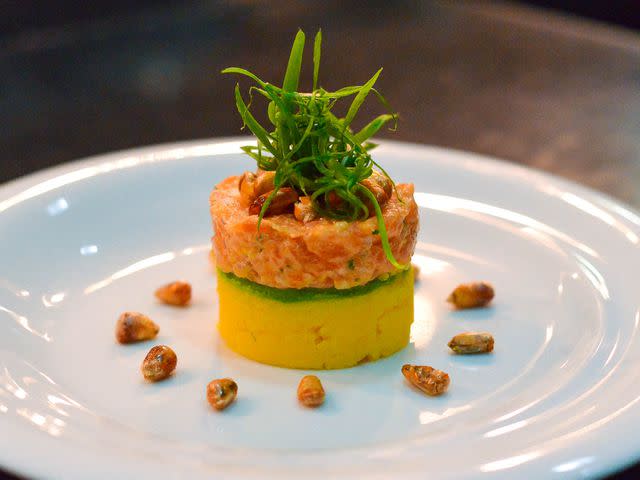
Serious Eats / Kevin Cox
This ubiquitous Quechan dish has taken on countless European-style variations, often served as a cake roll, terrine, casserole, or in colorful individual servings. Whatever the presentation, it starts with meaty mashed yellow Peruvian potatoes blended with lime, oil and spicy aji amarillo sauce. Shredded tuna, salmon, or chicken are mixed with mayo, followed by layers of avocado, hardboiled eggs, and olives. That surface is topped again with more potato mix, and so on, making as many lasagna-like layers as one dares. This bright, barely-spicy dish is served cold as a salad course or side dish.
Rocoto Relleno (Stuffed Spicy Peppers)
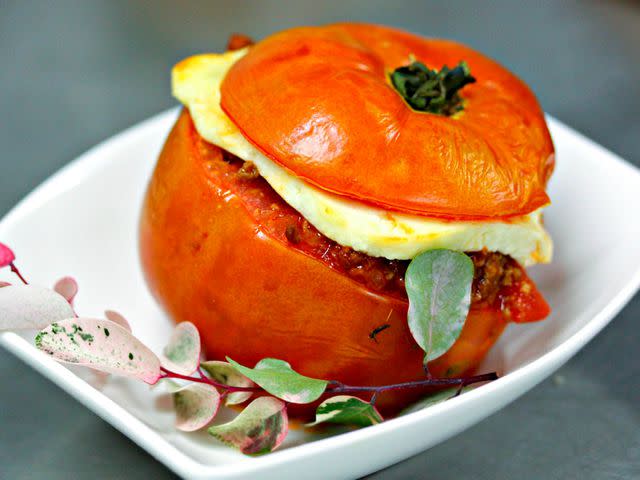
Franz Conde / Flickr
Red aji rocoto chiles are stuffed with a cooked mix of ground beef, onions, garlic, olives, raisins, herbs, and spices, then topped with queso fresco and baked in an egg-and-milk sauce. Fair warning: despite its scarlet good looks, this dish is not the stuffed bell pepper you're used to—the rocoto is a little larger than a plum with a bright, fruity, tropical berry essence and almost twice the heat of an aji amarillo (or about ten times hotter than an average jalapeño). So that first bite will wake you up. But the chile's initial burn is quickly tempered by the sweet and savory filling inside, and the melted queso fresco and eggy cream sauce in which it all cooks.
The rocoto chile originated in the southern region of Arequipa, and while it's now ubiquitous throughout the country, it's still hard to find beyond Peru's borders, which makes rocoto relleno a dish that homesick Peruvians pine for when abroad.
Anticuchos de Corazón (Grilled Heart)
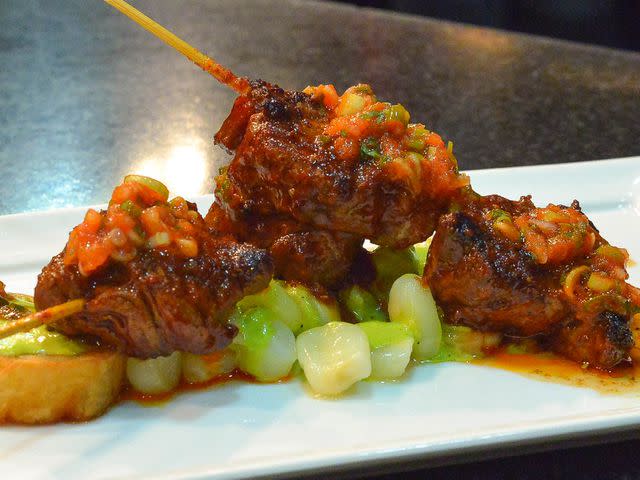
Serious Eats / Kevin Cox
Don't let "heart" put you off. The heart is a muscle, after all, leaner than filet mignon, bolder in flavor than a ribeye, and delicious when licked by open flames. Typically cut into one-to-two-inch cubes, the crimson heart (alpaca or beef) is marinated in vinegar, cumin, ají, and garlic and grilled over charcoal to a medium rare with slightly singed edges.
Those cubes are often served on skewers with sliced onion or potato, and drizzled with lime, which makes them popular appetizers and even more popular street food throughout the country. Today, cooks make anticuchos out of any cut of beef, and even chicken, but nothing beats the original cardiovascular version.
Arroz con Pato (Rice With Duck)
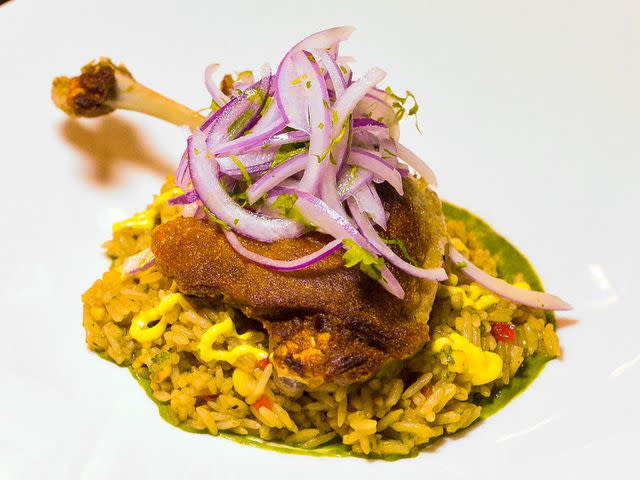
Serious Eats / Kevin Cox
This seemingly simple Spanish Criollo recipe is a signature dish in Peru. Rice is cooked in cilantro paste, herbs, and dark beer, giving a deep, earthy flavor to the vegetal grain. A roasted thigh and leg or—if lucky—crisp-seared duck confit is added on top of a mound of the green rice. The dish is so popular, it's found on nearly every Peruvian family table as well as at the finest restaurants in Lima, and like much of Peruvian cooking, it's been adapted into countless variations of rice mixture, texture and duck parts—and even with chicken or other poultry.
Pollo a la Brasa (Roasted Chicken)
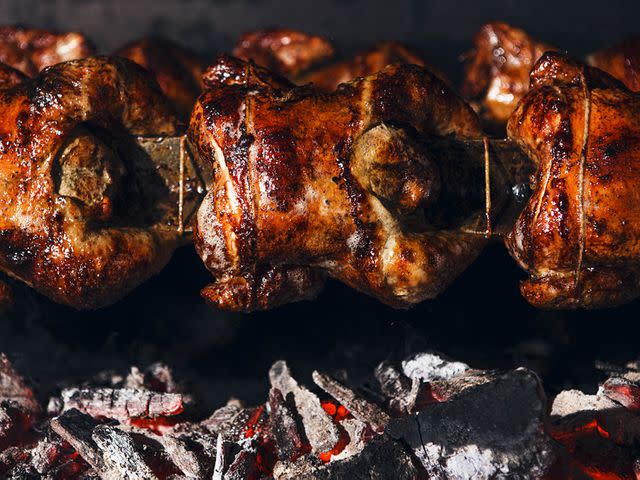
Serious Eats / Brian Oh
Perhaps the most well-known Peruvian food in the US due to the many take-out Peruvian chicken rotisserie joints around (see our roundup of DC's best). A whole chicken is marinated in a powerful combination of garlic, herbs, and spices before roasting on a spit, giving the bronzed, crispy skin an addictively exotic and earthy taste. Perhaps even more beloved than the chicken itself is the green huacatay (Peruvian black mint) sauce served next to it: every chicken comes with it, though the recipe often varies and is a closely-guarded secret. For some it's a creamy melange of the mint with cilantro, garlic and chile in a mayo base that Peruvians (and everyone else) goes crazy for. If you can't make it to Peru, this is definitely a classic worth making on your own.
June 2015
Read the original article on Serious Eats.

